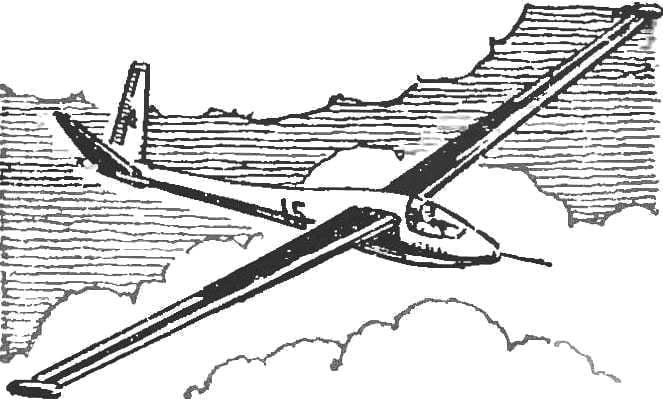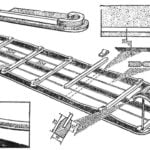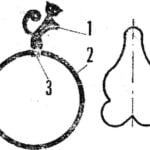 Glider-soaring leader A-15 created by the design team, headed by the General designer, Antonov ASTC, in 1959 and was designed with the latest achievements of gliding in the USSR and abroad. Built in series and for many years was extensively exploited in gliding clubs in the country and abroad, for example in Hungary and the Netherlands. It has more than 20 national and world records.
Glider-soaring leader A-15 created by the design team, headed by the General designer, Antonov ASTC, in 1959 and was designed with the latest achievements of gliding in the USSR and abroad. Built in series and for many years was extensively exploited in gliding clubs in the country and abroad, for example in Hungary and the Netherlands. It has more than 20 national and world records.
The glider is an all-metal high-plan with a cantilever wing, V-obraznym plumage and one-wheeled retractable landing gear.
A record of modern gliders are divided into two groups. One standard class of relatively simple designs, with a wingspan up to 15 m and without mechanization it.
The second group of gliders open class with unlimited wingspan with any mechanization. These include the A-15. That’s what his design.
The single-spar wing power circuit with a metal shell, two detachable consoles is at the root of the laminar profile a PASS 643 618. The shape of the profile is provided by the thirty ribs. Each consists of two parts — the tip and tail. The bow of each rib to obtain more exactly the profile of the wing is assembled from two halves — top and bottom. The wing spar beam type, consists of a wall and two shelves, made of duralumin extrusions t-section. The wing has a retractable slotted flaps, drooping ailerons and air brakes.
The ailerons of the wing naselenie consist of two parts separated in scope, made using plastic. Each is suspended from the wing at six loops.
The flap of the wing, with a deviation of 18°, the slit, sliding. mounted on four brackets with rollers that run on rails mounted in the wing. When the deviation of the flaps reduced landing speed and flight speed when hovering. To increase gliding angle when landing and reduce speed of run serve as brake pads placed behind the spar each console between the seventh and tenth ribs and consisting of two halves — top and bottom. When the brakes are closed, they fit into the contour of the wing. When they released, that constitute the plates set at right angles to the oncoming flow. These plates break the smooth flow of the wing by air, which dramatically increases the air resistance of the glider and increases the speed of his decline. Using flaps and air brakes, you can be confident to land the glider on a small platform. The wing tips with the purpose of protection from contact with the ground installed fairings are made of fiberglass. Between the first and fourth ribs placed pots for vocabulist.
The fuselage of semi-monocoque structure consists of 19 frames, metal siding and landing skids. The connection of plating is carried out by point welding, glue and rivets wpoty. In the top of the seventh and eighth frames has Central beams, which docked wing.
Light, and the cab is positioned before the seventh frame. The shape of the lantern is well inscribed in the contour of the fuselage frame it is made of pipes. The seat of the pilot is made of sheet duralumin, and the backrest frame is welded from steel pipes. The backrest can be adjusted. Distance from pedals to seat is also adjustable for growth pilot. Under the fuselage between the eighth and ninth frames is a niche of the chassis where the wheel is retracted, after which the niche closed doors. Air brakes are controlled by a handle located in the cockpit on the left. At the nineteenth frame is attached to the crutch, consisting of a spike heel and shock absorber. In the forward fuselage between the first and second frames of the towing fortified castle, and in the wear of the fuselage, the receiver pointer speed. The wing with the fuselage going very quickly with the help of the connecting bolts and parts docking UPRAVLINNYA in the wing.

Glider provides for the installation of oxygen equipment and radios. Power supply provided by the battery. On the dashboard of the pilot includes the following instruments: magnetic compass, artificial horizon, air speed indicator, altimeter two-point, high-sensitive variometer indicator oxygen pressure gauge and clock. At the bottom is the switch turning the unit on top of the handle of the tow lock.
Empennage a V-shaped, consisting of two surfaces set at an angle of 45° to the horizontal plane. Each surface is divided respectively into two: stationary and tiltable. Stationary surface perform the function of the keel and stabilizer. Rejected work as elevators and directions. The simultaneous deviation of both halves of the rudders left and right is done using the pedals, up and down — corresponding longitudinal movement of the control stick.
The fixed part of the tail collected from ribs, spars and skin, which is connected with the ribs on the glue. The rudders consist of spar, ribs and rim, covered in fabric.
The chassis consists of a wheel 300X125 mm, fully retractable in flight. It is mounted on the fork to the bracket, placed in the eighth frame. Cleaning and landing gear are carried out mechanical — lever located to the right of the pilot. The wheel is suspended to the fork on the shock absorber.
The color of the glider And is 15 usually the following: silver wings and a fuselage. At the center of the fuselage along its length held a red tapering stripe. The front part of the fuselage in front of the lantern is painted black. The plumage on the top and bottom painted red stars. The ailerons on both sides painted in red color. On Board of the glider between the wing and the tail letters “DOSAAF”.
Basic data of glider A-15 the following: wing span— 18 m; length — 7,20 m; wing area -12,3 m2; weight empty 310 kg; flying weight — 390 kg; the highest quality of planning — 40 on the flight speed of 100 km/h; minimum speed to reduce to 0.69 m/s at a speed of 90 km/h; rate of descent at a speed of 140 km/h — 1.35 m/s; the minimum rate of descent with flaps, deflected by 18°, — 0.75 m/s at a speed of 85 km/h Landing speed 70 km/h.



